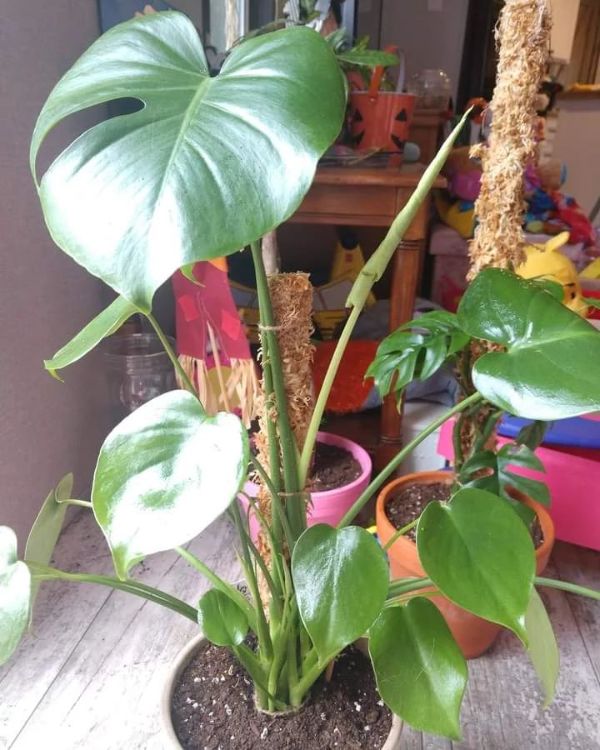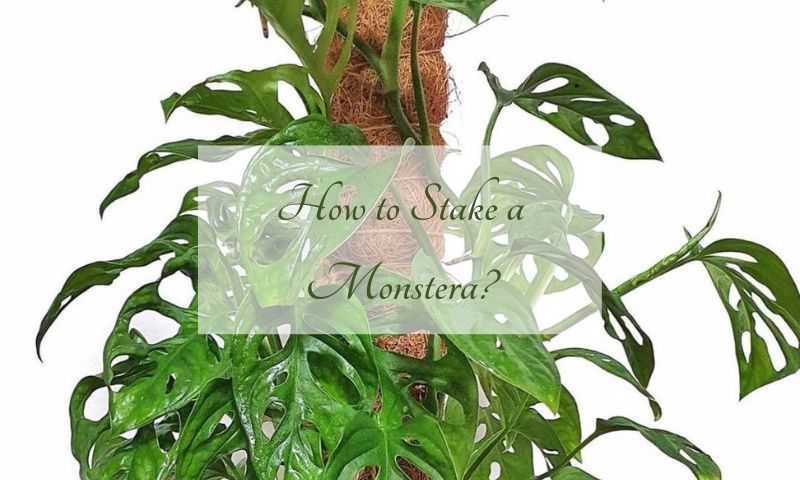Monstera plants, also known as Swiss cheese plants ’cause of their funky leaves, are a cool way to bring some green vibes and freshness to your place. Monsteras are pretty easy-going with basic needs like bright but not direct light, room temperature, enough humidity, and regular water – but making sure you stake it right is key for the best growth and looks. In this guide, we’ll show you how to stake a Monstera to make it grow its best, along with tips and tricks that can help you out – from picking the right soil and tools to using stakes of different sizes. With some advice from us, you’ll soon have a thriving Monstera with healthy leaves!
How to Stake a Monstera?
Monstera deliciosa, a top pick among houseplants, can get pretty big and often needs a helping hand to keep it growing straight. If your Monstera is getting too big for its boots or leaning over, staking gives it the support it needs. Here’s a play-by-play on how to stake your Monstera:
Materials Needed:
- A stake
- A soft tie (wire or plastic)
- Water
Procedure:
- Pick the Right Stake: The stake should be as tall as your Monstera’s pot. You can go with different materials, like bamboo, wood, or metal, each with their own cool look and job.
- Put in the Stake: Place the stake about 2 inches from the plant’s stem and give it a firm push into the soil.
- Tie the Monstera to the Stake: Using a soft tie, gently fasten the plant’s stem to the stake. Make sure to tie it loosely so you don’t hurt the stem or leaves.
- Give it Water: Give your Monstera a good drink after staking.
Additional Tips:
- Monsteras like to dry out between drinks, so make sure the soil totally dries out before watering again to keep from making it too soggy and causing root rot.
- Keep an eye out for bugs and sick-looking leaves, like mealybugs, scale bugs, spider mites, leaf spot, and powdery mildew. Quick action is key if you see any of these problems.
Staking your Monstera not only helps it grow upright but also helps it stay healthy and firm, making sure your plant stays a bright and eye-catching part of your indoor jungle.

Wire Cage Method
To stake your Monstera using this technique, first whip up a wire cage that’s a bit bigger than your plant. You can pull this off by bending and hooking a bunch of pieces of wire together until you’ve got something sturdy. Then, just pop the cage around your Monstera and keep it there with rocks or something else heavy.
This trick’s a great way to hold up your plant’s big leaves and help ’em grow upright instead of flopping all over the place.
Wire Method
If you want something simpler, you might want to go with staking your Monstera the wire way. Just make a few loops around your plant with a piece of wire. These loops gotta be strong enough to carry the weight of your Monstera’s leaves, but not so strong they keep the plant from spreading out. Once you’ve got something solid, just weigh it down with rocks or other heavy stuff.
Moss Pole or Trellis Technique
Another idea for staking your Monstera is to use a moss pole or trellis. Just tie a piece of string or something to your stake and then wind it around the bottom of your plant a bunch of times until you’ve got something solid. Stem Stakes Trick: Or you could go with stem stakes for staking your Monstera. Stem stakes are just long, tough sticks that you can use to help your plant’s leaves.
Stacking Stakes Method
You might also want to give stacking stakes a go when staking your Monstera. Stacking stakes means using a few smaller stakes all lined up in a tall stack around your plant instead of one big one. Through the Leaves Trick: Another way to stake your Monstera is to go right through the leaves. To pull this off, just stick a solid stake right through the middle of a few leaves on your plant until it gets to the bottom.
Though this might sound a bit wild, it can be a good way to hold up your Monstera’s large and heavy leaves. Once you’ve picked out and fixed the right stake for your Monstera, don’t forget to keep an eye on your plant’s health and move your stake around if you need to. Staking a Monstera’s a big deal in helping it grow, so make sure you take this step seriously to give your plant all the backing it needs.
Related: Do you want to train monstera to climb? Please read this article: http://famiplants.com/how-to-get-monstera-to-climb-up/
Staking a Mini Monstera
When you’re growing Monstera plants, one big thing to get right is staking them so they can handle those big, sprawling leaves. Mini Monstera plants are tinier and more snug than the regular Monsteras, but they still need some solid staking to help them shoot up tall and sturdy.
To stake a Mini Monstera, start by sticking a tough stake into the soil near the base of your plant. You might like to go with a wooden or metal stake, whatever feels right and works best in your garden or pot. Then, carefully tie one of the plant’s bigger leaves to the stake using garden twine or some other strong string.
As your Mini Monstera gets bigger, keep tying up its leaves now and then and make sure it’s got all the support it needs as it spreads out. Staking your Mini Monstera is one of the top ways to make it grow tall and strong, and makes sure you get the best from your gorgeous indoor or outdoor plant.

When To Stake A Monstera?
When you’re trying to figure out if it’s time to stake a Monstera plant, there are a few signs you should watch for.
- Sprouting Air Roots: When a plant starts popping out monstera aerial roots, it’s telling you it needs some help. These air roots can go wild and take over your whole plant, so you’ve got to stake them to stop that from happening.
- Getting Too Big: When a Monstera gets too big for its pot, or has outgrown its spot, it’s time to stake it. When a plant’s not getting the backup it needs from its pot or holder, the stems and leaves can get too heavy and flop over. Staking your Monstera helps it stay upright and looking good.
- Sagging Leaves: When a Monstera plant begin to wither or droop, it means the plant might not be getting enough sun or water. When that happens, it’s super important to stake your plant so it can keep getting the support and care it needs.
- Main Stem Drooping: When a Monstera’s big stem starts to lean, it’s a sign that the main stem might be too heavy for what’s holding it up. When you notice that, you need to stake your plant to stop any more damage or harm.
Benefits of stake for Monstera plant
There are some real pluses to using a stake for Monstera plants that you shouldn’t ignore.
- Staking helps them grow healthy and strong and gives them the backup they need to stand up straight. It also stops the leaves from sagging or snapping from being too heavy, which can make your Monstera last longer.
- You can also bend the leaves into cool shapes, like ladders and umbrellas. Plus, staking gets the air moving around the plant, which might cut down the chance of getting sick from not enough fresh air. Using stakes can also help keep bugs and diseases away because they stop the leaves from rubbing up against other plants or surfaces that might have nasty germs.
- Staking’s a cheap and easy way to make your Monstera look good without spending a lot or making a big fuss. Stakes can be pulled out and put back when you need to, so they’re a top pick for anyone wanting to spruce up their Monstera plant.
Now that you know how to stake a monstera for the best growth, remember, the trick is to give it enough support so it can grow without tipping over. Be sure to pop in and see how your plant’s doing now and then, and move the support if you need to. For more advice on raising monsteras, don’t forget to check out Famiplants.

